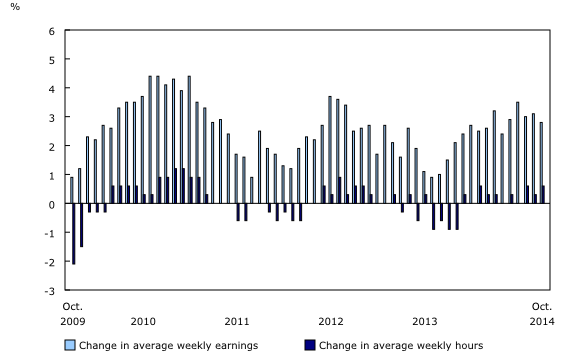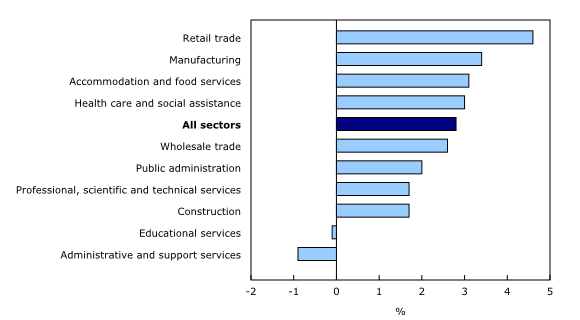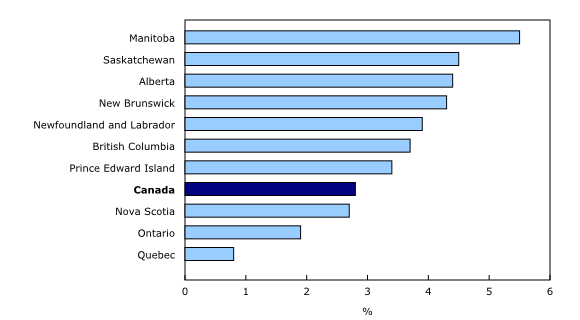Payroll employment, earnings and hours, October 2014
Archived Content
Information identified as archived is provided for reference, research or recordkeeping purposes. It is not subject to the Government of Canada Web Standards and has not been altered or updated since it was archived. Please "contact us" to request a format other than those available.
Released: 2014-12-22
Average weekly earnings of non-farm payroll employees were $942 in October, little changed from $939 the previous month. Average weekly earnings have hovered around $940 since July. Compared with 12 months earlier, weekly earnings increased 2.8%.
The 2.8% increase in weekly earnings during the 12 months to October reflected a number of factors, including wage growth, changes in the composition of employment by industry, occupation, and level of job experience, as well as average hours worked per week. Non-farm payroll employees worked an average of 33.0 hours in October, little changed from the previous month and up from the 32.8 hours observed in October 2013.
Average weekly earnings by sector
In the 12 months to October, average weekly earnings increased in 8 of the 10 largest industrial sectors, led by retail trade.
Compared with 12 months earlier, average weekly earnings in retail trade increased 4.6% to $554. Earnings growth was widespread in this sector, led by gains in general merchandise stores. Average weekly earnings in retail trade have been on an upward trend since the spring.
Compared with a recent low in October 2013, average weekly earnings in manufacturing were up 3.4% to $1,047 in October 2014. Gains in this sector were led by the chemical, paper, and miscellaneous manufacturing subsectors.
In accommodation and food services, average weekly earnings rose 3.1% on a year-over-year basis to $377 in October. Gains in average weekly earnings in this sector were mainly driven by full-service restaurants and limited-service eating places.
Compared with a year earlier, average weekly earnings in health care and social assistance rose 3.0% to $866. Year-over-year earnings growth was led by nursing and residential care facilities.
In the 12 months to October, average weekly earnings were little changed in educational services as well as administrative and support services. These 2 sectors have recorded the lowest year-over-year average weekly earnings growth amongst the 10 largest industrial sectors since May 2014.
Average weekly earnings by province
Year over year, average weekly earnings of non-farm payroll employees increased in every province in October. The gains were led by Manitoba, while Ontario and Quebec had the lowest earnings growth.
Average weekly earnings in Manitoba were $873 in October, up 5.5% compared with 12 months earlier. Year-over-year earnings growth in Manitoba has been the highest among the provinces since August. In the 12 months to October, growth was spread across most sectors in the province, led by health care and social assistance, and educational services.
In Saskatchewan, average weekly earnings rose 4.5% year over year to $985, with growth spread across most sectors. Earnings in this province have been trending upward since October 2013.
In the 12 months to October, average weekly earnings in Alberta increased 4.4% to $1,172. Most of the gains in the province were among high-earning industries such as real estate and rental and leasing; mining, quarrying, and oil and gas extraction; transportation and warehousing; and manufacturing.
Year over year, average weekly earnings in New Brunswick were up 4.3% to $843, reflecting earnings growth in administrative and support services, manufacturing, and educational services.
Average weekly earnings in Canada's two largest provinces recorded the lowest year-over-year growth. Compared with October 2013, average weekly earnings increased 1.9% to $941 in Ontario and 0.8% to $858 in Quebec.
Non-farm payroll employment by sector
Total non-farm payroll employment rose by 14,600 in October, following an increase of 14,300 in September. The largest employment gains in October were in educational services; transportation and warehousing; and retail trade. These increases were partly offset by notable declines in wholesale trade, and accommodation and food services.
On a year-over-year basis, the number of non-farm payroll employees rose 150,800 or 1.0%, with all of the gains occurring since April 2014.
Over the 12-month period, employment growth was highest in real estate and rental and leasing (+4.4%); mining, quarrying, and oil and gas extraction (+3.9%); and construction (+3.4%). At the same time, the largest declines in payroll employment were in utilities (-1.5%); information and cultural industries (-1.4%); and public administration (-1.3%).
Rebound in educational services employment in British Columbia
There was a strike among public sector primary and secondary school teachers in British Columbia that started in June and continued until the third week of September. British Columbia employment in the educational services sector as a whole rebounded by 14,400 between September and October, following a decline of 15,700 between August and September (see "Measuring the impact of labour disputes with SEPH" in the note to readers). In October, employment in the British Columbia primary and secondary schools subsector returned to a level similar to those observed for the month of October in previous years.
Note to readers
The Survey of Employment, Payrolls and Hours (SEPH) is produced by a combination of a census of payroll deductions, provided by the Canada Revenue Agency, and the Business Payrolls Survey, which collects data from a sample of 15,000 establishments. The key objective of SEPH is to provide a monthly portrait of the level of earnings, and the number of jobs and hours worked by detailed industry at the national, provincial and territorial level.
Estimates of average weekly earnings and hours worked are based on a sample and are therefore subject to sampling variability. This analysis focuses on differences between estimates that are statistically significant at the 68% confidence level. Payroll employment estimates are based on a census of administrative data and are not subject to sampling variability.
Statistics Canada also produces employment estimates from its Labour Force Survey (LFS). The LFS is a monthly household survey, the main objective of which is to divide the working-age population into three mutually exclusive groups: the employed (including the self-employed), unemployed and not in the labour force. This survey is the official source for the unemployment rate and collects data on the socio-demographic characteristics of all those in the labour market.
As a result of conceptual and methodological differences, estimates of changes from SEPH and LFS do differ from time to time. However, the trends in the data are quite similar.
Unless otherwise stated, this release presents seasonally adjusted data, which facilitates comparisons by removing the effects of seasonal variations. For more information on seasonal adjustment, see Seasonally adjusted data – Frequently asked questions.
Non-farm payroll employment data are for all hourly and salaried employees, as well as the 'other employees' category, which includes piece-rate and commission-only employees.
Average weekly hours data are for hourly and salaried employees only and exclude businesses that could not be classified to a North American Industry Classification System (NAICS) code.
All earnings data include overtime pay and exclude businesses that could not be classified to a NAICS code. Earnings data are based on gross taxable payroll before source deductions. Average weekly earnings are derived by dividing total weekly earnings by the number of employees.
With each release, data for the current reference month are subject to revision. Data have been revised for the previous month. Users are encouraged to request and use the most up-to-date data for each month.
Measuring the impact of labour disputes with SEPH
Employees involved in a labour dispute (that is, on strike or locked out) are not on the payroll deductions remittance (PD7). Therefore, they are not included in the SEPH earnings estimates but contribute to a decline in the level of employment.
The survey is not designed to measure the specific impact of labour disputes on earnings, hours worked or total employment; however, some of the impact can be reflected in the estimates. It is not possible to separate the impact of labour disputes from changes in the estimates due to other reasons.
A data table is available from the Browse by key resource module of our website under Summary tables.
Data on payroll employment, earnings and hours for November 2014 will be released on January 29, 2015.
More information about the concepts and use of the Survey of Employment, Payrolls and Hours is available online in The Guide to the Survey of Employment, Payrolls and Hours (Catalogue number72-203-G), from the Browse by key resource module of our website under Publications.
Contact information
For more information, contact us (toll-free 1-800-263-1136; 514-283-8300; infostats@statcan.gc.ca).
To enquire about the concepts, methods or data quality of this release, contact May Roos (613-951-6014; may.roos@statcan.gc.ca), Labour Statistics Division.
- Date modified:




